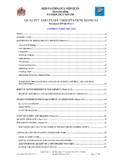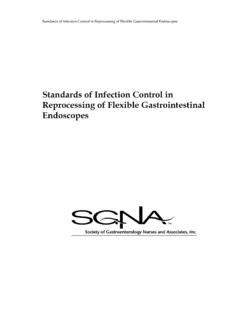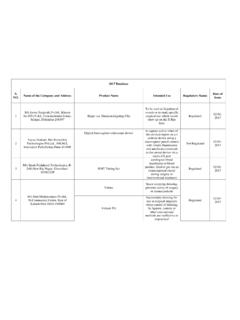Transcription of NATURE REVIEWS | ADVANCE ONLINE PUBLICATION
1 Cancers arise owing to the accumulation of molecular alterations in genes that control cell survival, growth, pro liferation, and differentiation within the nascent tumour. Currently, the molecular profile of cancers is typically assessed using DNA and/or RNA obtained from a frag ment of the primary tumour or a single meta static lesion; therapeutic strategies are subsequently defined accord ing to the molecular profile of the tissue. Importantly, however, the molecular profile of tumours evolves dynamically over time. The ability of tumours to evolve in response to a wide variety of endo genous and exo genous selective pressures has several implications: firstly, the genetic make up of individual cancers is highly hetero geneous; secondly, within a single patient, distinct metastatic lesions can be molecularly divergent; thirdly, therapeutic stress exerted on tumour cells, par ticularly by targeted drugs, can dynamically modify the genomic landscape of tumours1 5.
2 Of note, human blood samples contain materials including cell free DNA (cfDNA) and RNA (cfRNA); proteins; cells; and vesicles (such as exosomes) that can origi nate from different tissues, including cancers. Indeed, the rapid turnover of cancer cells is postulated to result in the constant release of tumour derived nucleic acids and vesicles into the circulation, and viable tumour cells can also separate from the tumour to enter the bloodstream. Thus, the ability to detect and characterize circulating cell free tumour DNA (ctDNA) and/or tumour derived RNA (predominantly microRNAs (mi RNAs)), and circulating tumour cells (CTCs), has enabled clinicians to repeatedly and non invasively interrogate the dynamic evolution of human cancers (FIG.)
3 1). The possibility of probing the molecular landscape of solid tumours via a blood draw, with major implications for research and patient care, has attracted remarkable interest among the oncology com munity; the term liquid biopsy is often used to describe this studies have illustrated the potential of liquid biopsy approaches to determine the genomic profile of patients with cancer, monitor treatment responses and quantify minimal residual disease, and assess the emer gence of therapy resistance. In addition to blood, several other body fluids such as urine7, saliva8, pleural effusions9, and cerebrospinal fluid (CSF)10, as well as stool11, have been shown to contain tumour derived genetic material, and our ability to exploit liquid biopsies for diagnostic purposes will further expand in the future.
4 The analysis of liquid biopsy specimens is, however, challenging because 1 Candiolo Cancer Institute Fondazione del Piemonte per l Oncologia (FPO), Istituto di Ricovero e Cura a Carattere Scientifico (IRCCS), Strada Provinciale 142, Km , 10060 Candiolo, Torino, Italiana per la Ricerca sul Cancro (FIRC) Institute of Molecular Oncology (IFOM), Via Adamello 16, 20139 Milano, of Oncology, University of Turin, Regione Gonzole 10, 10043 Orbassano, Torino, Cancer Center, ASST Grande Ospedale Metropolitano Niguarda, Piazza dell Ospedale Maggiore 3, 20162 Milano, of Oncology and Haematology Oncology, University of Milan, Via Festa del Perdono 7, 20122 Milano, to ONLINE 2 Mar 2017 Integrating liquid biopsies into the management of cancerGiulia Siravegna1 3, Silvia Marsoni1, Salvatore Siena4,5 and Alberto Bardelli1,3 Abstract | During cancer progression and treatment, multiple subclonal populations of tumour cells compete with one another.
5 With selective pressures leading to the emergence of predominant subclones that replicate and spread most proficiently, and are least susceptible to treatment. At present, the molecular landscapes of solid tumours are established using surgical or biopsy tissue samples. Tissue-based tumour profiles are, however, subject to sampling bias, provide only a snapshot of tumour heterogeneity, and cannot be obtained repeatedly. Genomic profiles of circulating cell-free tumour DNA (ctDNA) have been shown to closely match those of the corresponding tumours, with important implications for both molecular pathology and clinical oncology. Analyses of circulating nucleic acids, commonly referred to as liquid biopsies , can be used to monitor response to treatment, assess the emergence of drug resistance, and quantify minimal residual disease.
6 In addition to blood, several other body fluids, such as urine, saliva, pleural effusions, and cerebrospinal fluid, can contain tumour-derived genetic information. The molecular profiles gathered from ctDNA can be further complemented with those obtained through analysis of circulating tumour cells (CTCs), as well as RNA, proteins, and lipids contained within vesicles, such as exosomes. In this Review, we examine how different forms of liquid biopsies can be exploited to guide patient care and should ultimately be integrated into clinical practice, focusing on liquid biopsy of ctDNA arguably the most clinically advanced REVIEWS | CLINICAL ONCOLOGY ADVANCE ONLINE PUBLICATION | 1 REVIEWS 2017 Macmillan Publishers Limited, part of Springer NATURE .
7 All rights is fragmented and highly under represented com pared with germ line cfDNA12, and only a limited number of CTCs can be isolated from a blood sample13. Thus, analysis of tumour material obtained by liquid biopsies requires highly sensitive assays, which became available only within the past 5 years14. Herein, we provide a brief overview of the various types of tumour derived material that can be sampled using liquid biopsies. Subsequently, we discuss how different forms of liquid biopsy can be exploited in patient care and should ultimately be inte grated into clinical practice, focusing primarily on those related to ctDNA that, arguably, have the greatest clinical utility at liquid biopsiesA range of tumour components can be isolated from the blood.
8 Molecular analysis of these different components can provide distinct and complementary information (TABLE 1).CTCs: content analysis and experimental models. CTCs are tumour cells that have, presumably, intravasated or been passively shed from the primary tumour and/or metastatic lesions into the bloodstream. The existance of CTCs was first reported in 1869 by the Australian physician Thomas Ashworth15, but their clinical utility was not appreciated until the late 1990s16. CTCs can be isolated from the blood of patients with cancer, either as single cells or in cell clusters, and the number of CTCs detected has been associated with treatment outcomes and overall survival17. The abundance of CTCs in the blood is low (approximately 1 cell per 1 109 blood cells in patients with metastatic cancer), however, and varies between tumour technologies have been implemented to isolate CTCs13,19 22, and have been extensively reviewed elsewhere23.
9 Briefly, CTCs can be isolated through negative enrichment based on their size and other biophysical properties, or by positive enrichment using markers commonly expressed on the surface of these cells, such as epithelial cell adhesion molecule (EpCAM)23. Of note, we still lack markers that enable CTCs to be distinguished from nonmalignant epithelial cells, although direct imaging has been used in combina tion with functional assays to identify CTCs. Size based selection methods exploit the fact that CTCs are usually larger than normal blood cells24,25. Importantly, how ever, this approach probably results in considerable loss of CTCs that could be overcome by using cocktails of antibodies for positive selection of these cells.
10 Moreover, various approaches, including protein, DNA, and RNA analyses, can be applied to explore the content and facilitate the identification of , once isolated ex vivo, CTCs can be molecularly characterized and used in functional assays in vitro and in vivo, in order to provide insights into the cancer biology, as reported by several groups26,27. Notably, Yu and colleagues28 isolated CTCs from six patients with metastatic luminal breast cancer and cultured them in vitro for >6 months. Establishing cell lines of CTCs derived from other cancer types has, however, proved challenging. For instance, creation of permanent cell lines using CTCs isolated from patients with colorectal cancer is ineffective, with only one suc cesful example reported to date29.


